Craig Gillespie’s Fright Night pits high school kid Charley Brewster (Anton Yelchin) against vampire-next-door, Jerry (Colin Farrell). Visual effects supervisor Joe Bauer takes us through the gory details on this DreamWorks stereoscopic feature, from the opening shot through to the dramatic vampire transformations. Warning: contains spoilers.
fxg: Can you describe the range of visual effects in Fright Night?
Bauer: The interesting thing about Fright Night compared to the big effects films that have come out this year is that although it was small in the number of shots – about 400 – it managed to touch on every aspect of visual effects work that you can throw at a movie. We had simple two layer composites, some beauty work and invisible effects like adding shadows to a wall, through to complex full-3D environments and virtual camera moves. And it also ranged from a single artist working on a shot through to companies like Digital Domain and Luma Pictures completing the work.
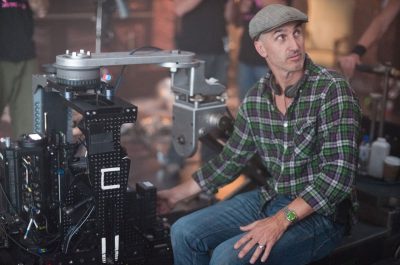
fxg: Let’s start with the opening shot, which goes down into the neighborhood.
Bauer: The opening shot was executed by Eden FX. It’s a full 3D environment, with a camera moving from the dimensionalized DreamWorks logo down through CG clouds, through a CG stormy environment with lightning and rain, then breaking through and transitioning to a helicopter shot filmed in Albuquerque at sunset, moving in on the housing development where most of the action takes place. It was approved late in the game – it was needed almost as soon as it was conceived – so they just had to dive in. They did a 3D test and we actually used that in an audience preview, and they really liked it so the shot ended up in the movie.
Eden had to do a pretty extensive matte job of that plate to make it a stormy environment. They added a lot of atmospherics and effects animation to that. We looked at reference of opening aerial footage, but basically Eden relied on a verbal description from the director, Craig Gillespie. The less elaborate version would have been to fade down through the DreamWorks clouds and then immediately go into the neighborhood, but Craig really felt it would be a more interesting way to start the movie and a more classic horror adventure approach, and to open up the movie which is all about claustrophobic spaces and scenes – it’s the one moment where the movie gets to breathe. We got to show the world area to the horizon and then narrow in on that house and get into the story.
fxg: There’s some large effects in the end sequences, but what other kind of invisible or smaller scale work was there?
Bauer: Well, it was a story point for Jerry, Colin Farrell’s character, that as a vampire that he doesn’t cause any reflections. We had two individual artists, Craig Crawford and Jabbar Raisani, who worked on shots like these. When Colin goes into a swimming pool to bite ‘Evil’ Ed (Christopher Mintz-Plasse), of course he’s reflecting in the water, so we had to remove his reflection but still maintain his presence, and that was a tremendous amount of paint.
Shade VFX worked on one interesting shot suggested by Steven Spielberg. One of the characters is holding a metal cross on a chain underwater and, as photographed, the hand releases the cross and it drops out of frame, and Steven thought it would be a much better shot if the camera was looking up and the cross tumbled down at the lens. That was a full CG shot by Shade and ended up being one of the most successful 3D shots in the movie.
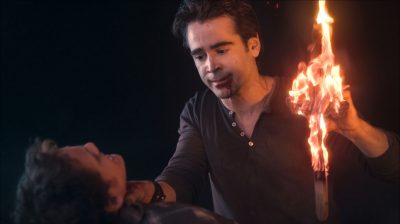 fxg: There’s a long shot following the family as they’re trying to escape Jerry – can you talk about that?
fxg: There’s a long shot following the family as they’re trying to escape Jerry – can you talk about that?
Bauer: Shade also worked on that shot in collaboration with Pixel Magic, which was the longest single take in the movie. Our heroes are escaping the house after Jerry causes it to explode. They’re all in a vehicle and in a long take they escape the neighborhood – they get out into the desert, Gerry throws a motorcycle through the back window, they kick it out and then e shows up in a pick-up truck, he side-swipes them and they run over him. The moment they hit him is the first cut in the sequence. So there’s lots of dialogue and the camera’s constantly moving from character to character through this whole scene.
The film was shot with a stereo rig holding two RED Mysterium X cameras – 80 to 90 pounds in weight – so the special effects guys had to modify a car that was cut into six pieces for this shot to work. What we did was manually puppeteer the car and even the actor to make room for the camera. So the action of the car and the actor sitting in the seat would be rolled out of the way the moment the camera couldn’t see that area, to make room for the body of the camera which was on a graphite arm and motion control rig. As soon as the camera cleared, the special effects guy would roll that piece of the car and the actor back into their places, so that it was back in position by the time the camera came around and saw it again.
The Third Floor did the original previs for the shot, which was great, and we stuck some real cameras into the real world objects and saw what needed to be moved and puppeteered as a test. Then we also took the same camera rig and mounted it onto a specially made camera car so that we could shoot 360 without ever seeing the car itself. We drove up and down the desert highways at dusk for the exteriors with the stunt work for Gerry’s truck, with just some CG fixes on the car mock-up to re-add things like the roof which we had removed.
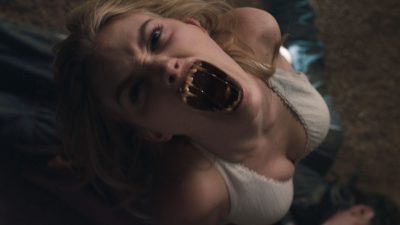 fxg: You mentioned the stereo rig – what were some of the particular challenges of working on a stereo film here?
fxg: You mentioned the stereo rig – what were some of the particular challenges of working on a stereo film here?
Bauer: All the plates were shot in stereo, apart from the aerial photography, as there was no rig in existence at the time that could handle a two-camera stereo system. In production, we had a great stereographer, Max Penner, and we could trust that all the cameras would be in the proper alignment and have the correct convergence. There are, though, inherent anomalies in the stereo cameras with the off-set cameras and mirrors. One eye will see reflections and another may see surface sheen, just from the way the light hits an object differently from another eye.
So there were several hundred shots where we would go in and change the shot slightly and the stereo effect so it didn’t result in an anomaly or eye strain, say for the bounce off a leather jacket or the amount of glow around a light bulb. In terms of just vfx shots, if you have 200 shots, you effectively have 400.
It’s interesting, too, the kinds of cheats you have to do to make it work in stereo that will need to be different for the 2D version. We had a shot that is an over the shoulder of Evil Ed as Charley stakes him, and the cameraman correctly holds focus on Charley’s face for the reaction. When we add the CG stake and all of the particle work and the embers that come into the lens and the blood that squirts at camera, as an audience member your eye will move from Charley’s face to that event.
That also needs to be in focus, so you actually have an impossible focus situation. You have the main actor in focus, you have Evil Ed who is standing a little bit closer to us, and then the stake coming through and the blood and embers which you’re now looking at. So you’ve got two planes of focus which photographically is impossible, but watching the movie it’s the right way to go. We would shift focus as much as we could with a post racking focus to the 3D event, but it would be something quick like blood squirting at the lens. It happens in so few frames that you just cheat the de-focus.
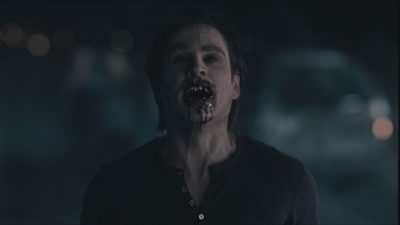 fxg: Probably the main effects work is the vampire transitions and final confrontation between Jerry and Charley. How were those shots designed?
fxg: Probably the main effects work is the vampire transitions and final confrontation between Jerry and Charley. How were those shots designed?
Bauer: Essentially, a vampire had a number of stages, and Jerry went through five. Howard Berger’s KNB FX team did a lot of practical effects and prosthetics, and in post we would do things as small as altering an eyeball through to replacing the lower half of the face, or in Colin Farrell’s case, making him disintegrate. When he is staked he becomes a full CG character and we used a particle-based solution for this.
During Jerry’s climatic fight with Charley, we go from prosthetic work by KNB FX to a full CG character when he gets to stage five, which is the ultimate stage of his vampire-ness as he is engulfed in flames. Fire stunts were all done practically by Bob Brown’s stunt team, with mostly stunt guys on wires, and sometimes the actors as well. We had to do some digital replacements for the hands and face when we could see the gel for the fire protection or prosthetics, or add extra fire.
The vampire spirits who are inhabiting Jerry’s victims from the neighborhood are released from their bodies, swirl around and we used Krakatoa to generate the look of the spirits in 3D. Krakatoa has a very sculptural quality in the way you can manipulate smoke particles. They all pull into Jerry’s stage five eviscerating body after he has already been burned up, and then he explodes.
fxg: What was involved in transitioning between stages?
Bauer: Jerry gets to stage four about half way through the movie and has an extended sequence on the highway. The design showed his mouth to be quite large and wrapping around his face, with his jaw able to hyper-extend and his teeth looking very shark-like. Howard Berger from KNB used the most advanced methods of pulling that off with prosthetics, but Steven Spielberg wanted that to go even further. So we took that over digitally with help from Luma. They ended up replacing Colin Farrell from the bridge of the nose down to his shirt collar. That meant they had to build a full mouth rig because the transformation needed to show how the teeth rolled out, pushed through the gums and pushed other teeth aside. Then we see that same kind of rig in the character Amy’s mouth when she becomes a vampire and looks up at the camera.
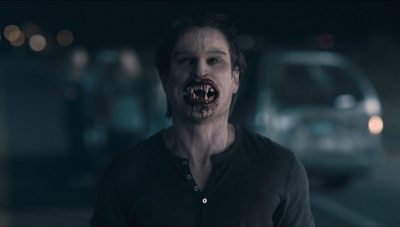 When we got the look that extreme, it wasn’t such a big jump from stage four to stage five, which was Jerry’s final look in the movie before he dies. So we had to push that final stage even further and sink his eyes and cheeks in more and make his features more angular with the bones jutting in. He makes that transition as he’s pushed into the sunlight and catching fire and eviscerating – so a lot of things are happening at once. For the shoot, we shot through all of the action with Anton, who ended up doing some of his own fire stunts, and then Colin and his stunt double who acted through Jerry’s death throes. We also filmed some clean plates so it could be all composited together.
When we got the look that extreme, it wasn’t such a big jump from stage four to stage five, which was Jerry’s final look in the movie before he dies. So we had to push that final stage even further and sink his eyes and cheeks in more and make his features more angular with the bones jutting in. He makes that transition as he’s pushed into the sunlight and catching fire and eviscerating – so a lot of things are happening at once. For the shoot, we shot through all of the action with Anton, who ended up doing some of his own fire stunts, and then Colin and his stunt double who acted through Jerry’s death throes. We also filmed some clean plates so it could be all composited together.
The final CG character at stage five was a full creation from top to bottom. We shot some fire elements that Luma was able to use, and they also generated digital fire, as did Digital Domain for the shots they worked on. It was all about getting Colin from stage four to stage five, and while he’s burning up he transitions back to the Jerry character as he was before becoming a vampire to signify his release from being one. As he’s dying, the spirits pull in and everything explodes.
